‘That bitch of a war’: Lyndon B. Johnson and Vietnam
Published in 20th-century / Contemporary History, Features, Issue 3 (May/Jun 2008), Volume 16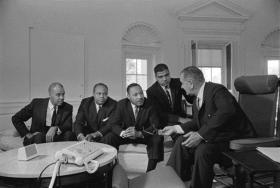
Johnson meets with civil rights leaders in the Oval Office in January 1964. From left: Roy Wilkins, executive director of the National Association for the Advancement of Colored People (NAACP); James Farmer, national director of the Congress of Racial Equality; Martin Luther King Jr, president of the Southern Christian Leadership Conference; and Whitney Young, executive director of the National Urban League. (Lyndon Baines Johnson Library)
Vietnam seemed an unlikely arena for what would become ‘Johnson’s War’, but the US had been engaged in south-east Asia since World War II. In 1940 France lost control of its colony, Indochina (Cambodia, Laos and Vietnam), to Japan. A Vietnamese independence movement, comprised of intellectuals and nationalists, was determined to resist the return of French colonial power in 1945. It was led by Ho Chi Minh, a demure but highly charismatic figure who left Vietnam in 1911 and travelled widely. During his time in France (where, incidentally, he expressed solidarity with the Irish revolutionaries executed in 1916) he embraced Marxism and returned to Vietnam in 1941 a committed communist. Ho’s success lay in his ability to unite the anti-French factions towards the single goal of independence and to develop a cohesive guerrilla army, the Viet Minh. While Ho did not lead a specifically communist revolution, his communism became an important factor in US support for France’s efforts to reassert its authority in Indochina.
Defeat of the French
President Franklin Roosevelt had emphasised the American desire for self-determination for all colonies, but US support for France in Indochina was determined by the Cold War. The US was determined to shore up France’s international prestige to ensure that it did not accommodate Soviet influence in Western Europe: Vietnam was little more than a sideshow in the US effort to halt the spread of communism in Europe. Beginning with no more than a tacit endorsement of France’s attempt to defeat the Viet Minh, by 1950 the US was bankrolling France’s military campaign. In spite of this support the French were decisively
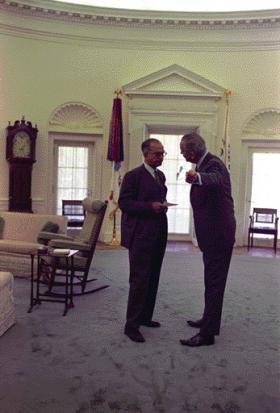
Johnson in conversation in the Oval Office with Democratic Senator J. William Fulbright, who pushed the Gulf of Tonkin Resolution through Congress. Two years later Fulbright opened Congressional hearings to investigate US policy in Vietnam and publicly questioned Johnson’s key advisers. (Lyndon Baines Johnson Library)
defeated at Dien Bien Phu in 1954 and forced to withdraw from Indochina. In the consequent settlement Vietnam was partitioned along the 17th parallel pending nation-wide elections. They were never held and by 1956 two states emerged: Soviet-backed in the North led by Ho Chi Minh (capital Hanoi), and US-backed in the South led by Nho Dinh Diem (capital Saigon). Vietnam thus became a key battleground in the undeclared war between the US and the USSR and remained so for the next twenty years. By 1960 a distinct guerrilla insurgency (the National
Liberation Front [NLF], designated ‘Viet Cong’ [Vietnamese Communist] by the Americans) was challenging the Saigon government and was eventually backed by Hanoi. The US continued to support Saigon, despite that government’s inability to win popular support, and ignored the clear signs that the insurgency was domestic in origin.
By the time Johnson became president in 1963 the Military Assistance Command, Vietnam (MACV), had been established and there were 16,300 US military advisers in South Vietnam, helping the Saigon government to combat the NLF insurgency that threatened to overwhelm it. Shortly before his death, Kennedy’s advisers stood by as a military coup overthrew and assassinated Nho Dinh Diem. Diem had rejected the introduction of US ground troops, fearing that it would undermine his authority and his nationalist credentials in the face of the communist challenge. In the wake of Diem’s demise, a series of unstable military governments came and went in Saigon, each one propped up with ever-greater levels of US aid. Johnson was wary of engaging the US in another ground war in Asia; the stalemate reached in Korea in 1953 hardly seemed a promising goal for his presidency. But he also feared charges that he was ‘soft’ on communism. Having committed so much to the defence of South Vietnam, Johnson believed that US credibility was on the line. His advisers never seriously considered withdrawing aid from South Vietnam, even as the situation in Saigon rapidly deteriorated during 1964.
Gulf of Tonkin Resolution
In August 1964 the administration concocted the pretext that would justify US bombing of North Vietnam and the introduction of ground troops: the Gulf of Tonkin Resolution, rushed through the US Senate without proper debate. It followed two apparently unprovoked attacks on US vessels off the coast of North Vietnam in what the US claimed were international waters. In fact, the US was engaged in secret reconnaissance missions, probably the rationale for the first attack. The second may never actually have occurred, but was the result of confusion and misunderstanding on the US vessel. The incidents themselves were important only in so far as they provided the rallying point for Johnson to gain Congressional support for military operations against North Vietnam. The resolution authorised Johnson to take whatever steps he deemed necessary to defend south-east Asia; it soon became clear that that meant US ground troops in Vietnam.
But Johnson was also concerned about an escalation of the conflict; he feared that if the US acted too rashly or harshly against North Vietnam, its communist sponsors, the People’s Republic of China and the USSR, might intervene, raising the possibility of direct superpower conflict and the spectre of nuclear confrontation. In order to prevent such an escalation, the Johnson administration formulated a military policy that was designed to:
(1) force, through bombing, the North Vietnamese to cease their support of the southern insurgents;
(2) defeat the insurgency in the South using US personnel;
(3) strengthen the Saigon government by winning the ‘hearts and minds’ of the people of South Vietnam.
While policies were developed to achieve these goals, the US military operation ultimately proved counterproductive. Operation Rolling Thunder, the bombing of North Vietnam, began in February 1965 and, despite its limited nature, had a devastating impact. In response to an NLF attack on the US air base at Da Nang, ground troops were introduced, heralding a new phase in the ongoing Vietnamese struggle to complete the revolution begun in the 1940s.
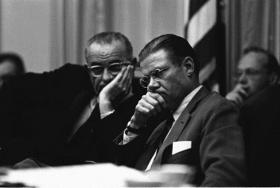
Johnson with Secretary of Defense Robert McNamara, who, along with Gen. William Westmoreland, formulated a military policy based on a strategy of attrition: US forces would kill more cadres than the enemy was able to replace until a ‘tipping point’ was reached. (Lyndon Baines Johnson Library)
US forces were ill suited to the Vietnamese style of fighting or the terrain. Johnson’s secretary of defense, Robert McNamara, and the US commander, Gen. William Westmoreland, were largely responsible for formulating the military policy, based on a strategy of attrition: the US would achieve its goal of subduing the insurgency in the South by killing more cadres than the enemy was able to replace. McNamara predicted that a ‘tipping point’ would eventually be reached, at which time the government in Hanoi would conclude that the war was too costly and would cease its support for the NLF. Unprepared for a guerrilla style of warfare, Westmoreland relied on the technique of ‘search and destroy’. US forces in big units sought out the enemy in rural areas of South Vietnam with the aim of surrounding and killing enemy combatants. US progress could only be measured by the infamous ‘body count’, which simply calculated the number of enemy combatants killed. But as the insurgents lived among the rural populations, it quickly became clear that it was difficult to tell the difference between enemy soldiers and South Vietnamese civilians. Civilians were also victims of the bombing and defoliation campaigns that accompanied the ground war. Believing that the enemy could be defeated by the removal of their hiding places in the jungles, the US engaged in a sustained effort to defoliate the forests of South Vietnam using herbicides and napalm. While the goal of winning the ‘hearts and minds’ of the people remained important to the US government, the pacification programmes were always secondary to the military conflict. Without the means to create a viable political regime in Saigon, the Johnson administration faced a potentially unending struggle to deny the insurgents victory. Furthermore, North Vietnam never reached the ‘tipping point’ that McNamara had originally predicted. Despite the continued bombing of North Vietnam and the high casualty rates suffered by its soldiers fighting in the South, Hanoi remained committed to the struggle. By 1967 it had become clear to Johnson and his advisers that the US faced a military stalemate in Vietnam.
The anti-war movement
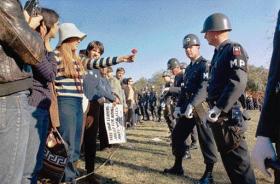
A female demonstrator offers a flower to military police on guard at the Pentagon during an anti-Vietnam demonstration on 21 October 1967. (National Archives, USA)
As Johnson began to conclude that there was no simple military solution to the conflict, he faced ever-increasing domestic opposition to his handling of the war. Some argued that Johnson should remove the restrictions on the military and accept total war in Vietnam, a policy that Johnson rejected for fear of escalating the conflict. These ‘hawks’ worried Johnson, but his greatest anxieties resulted from the anti-war movement. This movement is difficult to characterise but has been regularly stereotyped, first by the public and media during the 1960s and since by many historians. Most historians now agree that the core of the anti-war movement, centred on the demonstrative student activism of the New Left, was always a minority within the wider anti-war campaign. By 1967 many ordinary Americans had come to question the US role in Vietnam—a dramatic change from 1965, when an overwhelming majority supported the president and US intervention. Media coverage of the destructiveness of the war, including images of US soldiers returning in body bags, contributed to a war-weariness that was primarily based on the lack of progress in Vietnam. Many Americans were unable to understand why the US was in Vietnam in the first place and were even more perplexed by their government’s inability to explain how victory could be achieved. While popular support for the war declined, few were willing to endorse the withdrawal of US forces and hence a communist victory. Instead, weariness of the war led to a general sense of unrest that contributed to the growing social divide over such issues as civil rights. Johnson was more deeply affected by the defection of key individuals from his own political constituency. In 1966 Senator Fulbright, who had sponsored the Gulf of Tonkin Resolution, opened Congressional hearings to investigate US policy in Vietnam and publicly questioned Johnson’s key advisers. By late 1967 both Martin Luther King and Senator Bobby Kennedy had publicly voiced their opposition to the continuing war, calling for negotiations with the North Vietnamese and the NLF. King had responded to charges that black Americans were disproportionately drafted and killed in Vietnam, undercutting Johnson’s strong record on civil rights. Having always demanded a committed loyalty from his associates, Johnson was outraged by the opposition of his fellow Democrats.
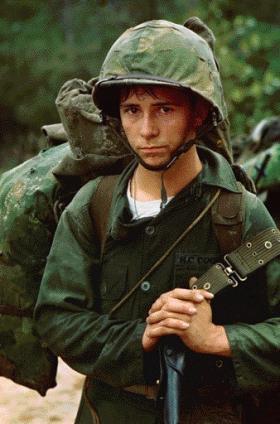
A young Marine private during a landing on 3 August 1965 at Da Nang, where US ground troops had first been introduced earlier that year. (National Archives, USA)
He also faced considerable pressure from the anti-war protest movement. Having begun his career as a teacher in rural Texas, Johnson believed that his focus on education and his efforts to achieve equality of opportunity for all young Americans was deserving of recognition. He was angered in particular by students who marched around the White House each day chanting, ‘Hey, hey, LBJ, how many kids did you kill today?’ In October 1967, tens of thousands of protesters joined a march on the Pentagon, resulting in violent clashes between protestors and military police. While many Americans were outraged by what they deemed unpatriotic acts of disobedience, the protests kept Vietnam in the media spotlight and on the domestic agenda. Americans also witnessed social unrest of another kind, as race riots gripped cities across the United States, from Los Angeles to Newark. Protests against the Vietnam War only added to the sense that law and order was breaking down. Johnson appeared to lose support from two key constituencies: working-class and middle-class Democratic voters who had rallied to his call for social reform but who were now angered by the apparent breakdown of order, and liberals who had supported the foreign policy consensus of the early 1960s but who now believed that Vietnam was a mistaken, even immoral, war. Despite such tensions, Johnson remained committed to seeking an acceptable solution to the war, one that would allow the US to maintain its international credibility and that would guarantee the existence of South Vietnam.
Despite Kennedy’s allegations, Johnson had sought negotiations with North Vietnam and the NLF. Hanoi demanded an end to the US bombing campaign as a precondition and continued to insist that the Saigon government was illegitimate, while Johnson would not engage in talks until the North Vietnamese agreed to withdraw their troops from South Vietnam and accept the right of the Saigon government to exist. In late 1967 it seemed that the stalemate could not be ended. In an effort to promote the idea that progress was being made, Johnson called Westmoreland back to Washington, where the general publicly stated that ‘there was light at the end of the tunnel’. He claimed that military progress was being made, and that the enemy was beginning to retreat. Within weeks of Westmoreland’s positive assessment, the American people were presented with a damning counter-image. On the eve of the Vietnamese New Year, Tet, the NLF and North Vietnamese launched attacks on the cities of South Vietnam. Guerrillas breached the outer wall of the US Embassy in Saigon and engaged in fighting with US soldiers for several hours. Militarily the Tet Offensive was a defeat for the NLF and North Vietnamese, but psychologically and morally it was a victory of unprecedented proportions. It appeared that the US government’s claims of progress had been lies, and a ‘credibility gap’ became increasingly obvious. Public support for the war plummeted in the immediate wake of Tet, and Johnson was left reeling from the defection of key foreign policy advisers, including the ‘wise old men’, a group of former secretaries of state and defense who now counselled that he seek negotiations. By this time McNamara had resigned, and the new secretary of defense, Clark Clifford, recommended negotiation and counselled Johnson to reject the military’s request for an additional deployment of 200,000 troops, a request that would have brought the total number above 700,000. Accepting that the war could not be won militarily, Johnson rejected the military’s request.
Johnson’s legacy
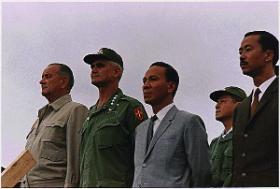
Johnson in Vietnam on 26 October 1966 with Gen. Westmoreland, Lt. Gen. Nguyen Van Thieu, South Vietnam’s ceremonial head of state, and Prime Minister Nguyen Cao Ky. Thieu was elected to a new executive presidency in September 1967, the last of a series of unstable military governments that came and went in Saigon. (National Archives, USA)
On 31 March 1968 Johnson made a televised address to the American people. He announced that he would offer the North Vietnamese a bombing pause in order to initiate peace talks, and surprised all by stating that he would not run for president in 1968. Having served only one full term, Johnson’s announcement came as a thunderbolt. It marked the end of a remarkable political career, and a new, albeit protracted, phase in the Vietnam War. The bombing pause was not initiated until November and peace talks did not formally open until January 1969. The Paris Talks, moreover, continued for a further four years, until the complete withdrawal of US troops in January 1973. Johnson’s decision not to seek re-election was based primarily on personal factors; he was exhausted by the toll the war had taken on him and believed that a new administration might be better placed to deal with the quagmire of Vietnam. The war undermined the Great Society and destroyed Johnson’s presidency, but it did not end with him. It became Richard Nixon’s war as he presided over the de-Americanisation of the conflict, more than 25,000 additional American deaths and countless Vietnamese casualties. In the end, the Vietnam War ended with communist victory in April 1975. Johnson did not witness the final destruction of South Vietnam: he died in January 1973. One lasting consequence of the Vietnam War, however, was the impact that it had on Johnson’s legacy. Despite his substantial efforts to achieve civil rights and to reform the systems of healthcare, education and welfare in the US, the Vietnam War continues to overshadow his presidency. Lyndon Johnson, the architect of so much of America’s involvement in its longest war, also became one of its victims.
Sandra Scanlon is a Government of Ireland Post-Doctoral Fellow and lecturer at the School of History and Archives, University College Dublin.
Further reading:
G. C. Herring, America’s longest war: the United States and Vietnam (New York, 2001).
F. Logevall, Choosing war: the lost chance for peace and the escalation of the war in Vietnam (Berkeley, 1999).
R. McMahon, Major problems in the history of the Vietnam War (Wilmington, 2003).
R. Schulzinger, A time for war: the United States and Vietnam, 1941–1975 (New York and Oxford, 1997).
















